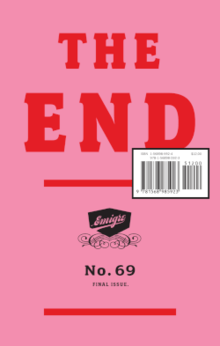Emigre (magazine)
Emigre (ISSN 1045-3717) was a graphic design magazine published by Emigre Graphics between 1984 and 2005; it was first published in 1984 in Berkeley, California, United States. Art-directed by Rudy VanderLans using fonts designed by his wife, Zuzana Licko, Emigre was one of the first publications to use Macintosh computers and had a large influence on graphic designers exploring the new technology. Its variety of layouts, use of guest designers, and opinionated articles also had an effect on the profession of graphic design in general.
 Issue 69 | |
| Editor | Rudy VanderLans |
|---|---|
| Categories | Graphic Design, Typography, Type Design |
| Frequency | usually on a quarterly basis |
| Paid circulation | 2,500 - 3000 |
| Unpaid circulation | 35,000 - 40,000 |
| Total circulation | 69 issues |
| First issue | 1984 |
| Final issue | 2005 |
| Company | Emigre Graphics |
| Country | United States |
| Based in | Berkeley, California |
| Language | English |
| Website | www.emigre.com/EMagView.php |
| ISSN | 1045-3717 |
The focus of Emigre was both redundant and wandering—both positive qualities as a journal produced by a tight and evolving group of designers and writers with Vanderlans at the center. Vanderlans was typically editor, though guest-editors also appeared (Gail Swanlund, Anne Burdick, Andrew Blauvelt) and the work/writing of Jeffery Keedy, Kenneth FitzGerald, Lorraine Wild and Diane Gromala reappeared throughout the magazine's history.
The magazine began in 1984 with a focus on the émigré. The first eight issues were concerned with boundaries, international culture, travel accounts and alienation (as the issues' titles suggest). The first eight issues also incorporated a dynamic aesthetic that caught the attention of designers and led to the next stage in the magazine's evolution.
Beginning with Issue 9—devoted to the art of Vaughan Oliver at 4AD—the magazine explored design in itself, devoting issues to Cranbrook, the Macintosh, type design and individual graphic designers.
Increasingly, Emigre became a platform for essays and writings on design. This aspect of Emigre came to the forefront with issues in 1994 and the magazine changed its format in 1995 from its oversized layout to a text-friendlier format that debuted with Issue 33. The magazine retained this character through Issue 59 in 2001.
Emigre then took a sharp turn with four re-formatted issues in 2001 and 2002 that included one DVD (Catfish, an experimental documentary film on the work of designer and performance artist Elliott Earls) and three compact discs (featuring the music of Honey Barbara, The Grassy Knoll and Scenic).
In its fifth and final incarnation, the last six issues of Emigre were co-published by Princeton Architectural Press as small softcover books. The last issue, The End, was published in 2005.
Formats
The magazine changed formats several times: it was originally published quarterly in a large format where each page measures 285 mm × 425 mm (slightly shorter than 11″ × 17″ or US ledger/tabloid size); starting with issue 33, each page was about 8.5″ × 11″ (US letter size); it changed into a multimedia format (a booklet where each page was 133 mm × 210 mm, plus a CD or DVD) starting with issue 60; and finally, starting with issue 64, the magazine became a book format, published semi-annually, where each page measured 133 mm × 210 mm. The issues in the book format were co-published by Princeton Architectural Press.
See also
- Communication Arts
- Graphis Inc.
- Print (magazine)
- Visible Language
References
- Design Observer article by Rick Poynor
- Emigre magazine's web page on Emigre's official web site
- Eye magazine, Vol. 2, No. 7, 1992, pp. 8–16: Rudy Vanderlans
- Eye magazine, Vol. 11, No. 43, Spring 2002, pp. 58–64: Zuzana Licko
- Merz to Emigre and Beyond: Avant-Garde Magazine Design of the Twentieth Century, Steven Heller, Phaidon, 2003